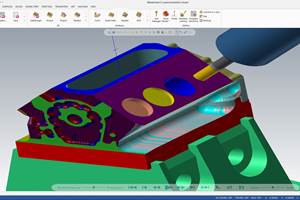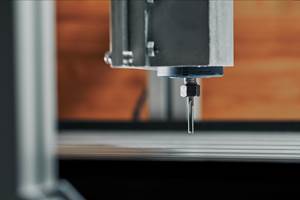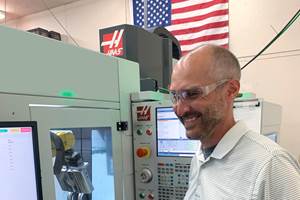ERP System Keeps New Work Center Fully Loaded
It's difficult for a small, specialized machine builder doing $1.5 million in sales annually to buy a $100,000 machine tool, then keep it fully loaded and realize a good return on investment without upsetting the workload throughout the shop—especially with the current manufacturing slowdown.
It's difficult for a small, specialized machine builder doing $1.5 million in sales annually to buy a $100,000 machine tool, then keep it fully loaded and realize a good return on investment without upsetting the workload throughout the shop—especially with the current manufacturing slowdown. But that's what Ontario Sewing Automation (Woodbridge, Ontario, Canada) has managed to do.
During the last 4 years, this 12-person machine builder grew 40 percent as a result of big increases in the custom machinery portion of its business. Last fall, the company president, Stephen Jeske, noticed that the horizontal milling machine was overloaded. He had no hard data to back up that observation, however, because the enterprise resource planning (ERP) system the company used made it difficult to generate reliable statistics or even schedule the shop.
"I invested in a big piece of machinery—a Milltronics RH 20 CNC milling machine," says Mr. Jeske. "Then I invested in new software to keep it loaded."
Just 2 months after buying the new Milltronics RH 20, Mr. Jeske abandoned the company's 18-month-old ERP system and replaced it with JobBoss from JobBoss Software/Exact (Minneapolis, Minnesota).
Most of the shop's jobs are multi-level assemblies—machines that start at $25,000 and go up from there—so the shop considers scheduling one of its biggest challenges. Every machine it builds is comprised of 100 or more component parts. Scheduling and completing those components on time is a feat that must be accomplished or the finished machine is late.
"We make machines used to sew industrial mops," says Mr. Jeske. "We take a sewing machine head and design and make the entire machine around that. We have a machine shop with lathes and milling machines to manufacture parts for our machinery, and a welding shop for welding frames. We do the painting. Virtually the only outside services we use are if we need something plated, rubberized or heat treated."
Growth at Ontario Sewing Automation continued until just recently, when the effects of the current manufacturing slump caused the shop's first slowdown in 4 years. "The orders are still trickling in, most of them from outside North America," admits Mr. Jeske. "It's ironic, but I'm finding we're able to use the slowdown to our advantage. Now that there's less for me to maintain on the shop side, it's the best time to be implementing changes."
As for the Milltronics RH 20, Mr. Jeske is still keeping it fairly well loaded—he needs a certain amount of volume to realize a return on the investment.
The other segment of Ontario Sewing's business is the production of sewing machine parts for use as spare parts and as stock for future jobs.
"Generally, we're building small quantities of parts for just one or two big machines on that mill," says Mr. Jeske. "But since we have JobBoss, I have a better handle on how much it costs to produce a part. If I have a 40-hour week, and next week I have 20 hours scheduled—there's a lot of extra time. If I've got a spare part to make, I can use JobBoss to figure out that I can squeeze in ten of those parts in the extra available time. That's what we're doing right now, making parts for stock. So we're keeping the equipment loaded and we're building job history. That history will be used to justify additional machinery purchases in the future."
Reliable data is making a difference in every facet of the business especially on costs. "In some cases, it's been a real eye opener," says Mr. Jeske. "Sometimes we were undercharging. And in some cases we thought we were undercharging but weren't."
Yes, business is down, but Mr. Jeske strangely relishes the break and is busy as ever. A JobBoss consultant visits monthly to advise the company of what to tackle next. "We did a trial balance for the fiscal year end. We now have AP and AR up and running. We always paid an inordinate amount of money for accounting help to get a trial balance 6 months after the year-end. We no longer need to do that."
Ontario Sewing Automation is seeing other improvements. Routings and material requirements no longer rest solely in the mind of the shop foreperson, but instead are on the computer for all to see. Now the shop operates with a complete bill of materials and knows immediately when it will run short—eliminating last minute ordering and waiting. And the horizontal mill is pulling its load, thanks to improved scheduling.
When business booms again, Mr. Jeske will have his ERP system working full steam. "Now we print out our reports and it's crystal clear what it cost to make something," says Mr. Jeske. "Before it was fuzzy. We had approximations, and it all came out in the wash. But I never liked that; I wanted to have good hard data. Now we do."
Related Content
CAD/CAM System Requirements: An Overview
CAD/CAM programs are among the most demanding kinds of computer software. Smooth operation requires careful consideration of computer specifications.
Read MoreFive Safety Considerations for CNC Machinists
Safety in CNC environments is essential for users – and for productivity. Consider these 5 points to avoid injury, part failure and downtime.
Read More5 Reasons Why Machine Shop Ownership Is Changing
Mergers, acquisitions and other ownership changes are an effect of Boomer-age shop owners retiring, but only in part. Also important: The way we think about machining has changed.
Read MoreTips for Designing CNC Programs That Help Operators
The way a G-code program is formatted directly affects the productivity of the CNC people who use them. Design CNC programs that make CNC setup people and operators’ jobs easier.
Read MoreRead Next
The Cut Scene: The Finer Details of Large-Format Machining
Small details and features can have an outsized impact on large parts, such as Barbco’s collapsible utility drill head.
Read More3 Mistakes That Cause CNC Programs to Fail
Despite enhancements to manufacturing technology, there are still issues today that can cause programs to fail. These failures can cause lost time, scrapped parts, damaged machines and even injured operators.
Read More




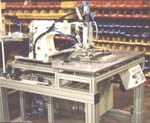
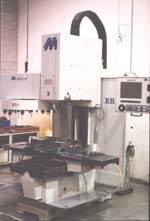






.png;maxWidth=300;quality=90)








